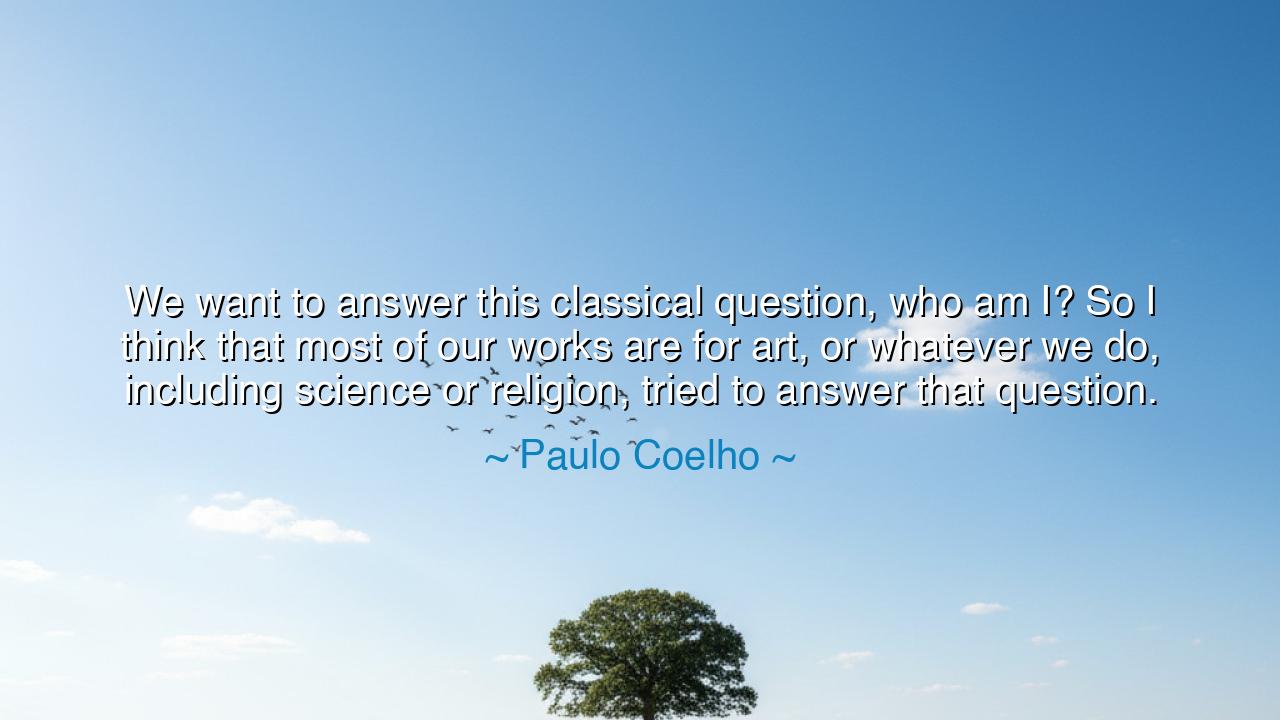
We want to answer this classical question, who am I? So I think
We want to answer this classical question, who am I? So I think that most of our works are for art, or whatever we do, including science or religion, tried to answer that question.






“We want to answer this classical question, who am I? So I think that most of our works are for art, or whatever we do, including science or religion, tried to answer that question.” Thus spoke Paulo Coelho, the Brazilian sage whose words flow like rivers toward the sea of human truth. In this reflection lies one of the oldest yearnings of mankind—the desire for self-knowledge, the search for identity beyond name and form. From the dawn of time, through the arts, the sciences, and the faiths of the world, humanity has pursued this one eternal inquiry: Who am I? Coelho reminds us that beneath every creation, every discovery, and every prayer, lies this silent question, burning within every heart.
For the artist, this search becomes a canvas; for the scientist, an equation; for the believer, a path of faith. In every age, people have turned outward to understand the inward. The sculptor carves the human form to discover the soul that gives it life; the astronomer maps the stars to glimpse the order that holds his own existence; the philosopher ponders truth to find his reflection in the mirror of thought. Coelho, who writes of destiny and the soul’s journey, sees all human striving—be it art, science, or religion—as threads woven into the same tapestry, all seeking the same image at its center: the image of the self, the mystery of being.
This question, “Who am I?”, is as old as consciousness itself. It thundered in the temples of Egypt, whispered in the meditations of India, and burned in the hearts of prophets and poets alike. The Oracle of Delphi bore the words, “Know thyself,” carved into stone as the highest wisdom of the ancients. Socrates repeated it as the foundation of philosophy, declaring that the unexamined life is unworthy of a human being. The Buddha sat beneath the Bodhi tree, unmoving, until he pierced the illusion of self and found enlightenment. And in every sacred text, from the Vedas to the Gospels, we hear echoes of the same truth—that to know oneself is to know the divine.
Consider the story of Leonardo da Vinci, who spent his life bridging the worlds of art and science. His paintings, such as the Mona Lisa, were not merely portraits—they were meditations on the nature of the human spirit. His notebooks, filled with studies of anatomy and flight, reveal a mind seeking unity between body and soul, matter and meaning. Leonardo’s life was an endless dialogue with the self, a dance between curiosity and creation. Through his work, he sought to answer what Coelho calls the “classical question.” And though he left thousands of pages unfinished, his search itself was his answer. For to seek truth is already to live it.
Coelho’s insight also reminds us of the unity of human expression. The scientist in his laboratory, the monk in his monastery, and the artist in his studio are not as different as they appear. Each is driven by the same hunger—to understand his place in the vastness of existence. The methods differ, but the destination is shared. The poet reaches for beauty, the theologian for faith, the physicist for law—but beneath all their pursuits lies the same prayer: What am I? What is this mystery that feels, thinks, and dreams within me? When Coelho speaks of “whatever we do” as an attempt to answer that question, he uncovers the spiritual core of all human endeavor.
And yet, Coelho also teaches humility. For the question “Who am I?” cannot be answered once and for all. It is not a riddle to be solved, but a journey to be walked. Each answer opens a deeper question; each discovery reveals a greater unknown. The self is not a static thing, but a living flame—changing, growing, learning. Thus, the wise do not seek to define themselves with finality, but to live in awareness, to become ever more honest with their own hearts. Art, science, and religion are the mirrors by which humanity glimpses its reflection, but the reflection itself is infinite.
So, my child of wonder and thought, take this truth to heart: your life is your answer to the question, “Who am I?” Every choice you make, every word you speak, every act of love or courage, is part of that unfolding revelation. Do not look only to others for meaning—look within. Create as the artist does, question as the scientist does, pray as the seeker does. Let your actions become your philosophy, your days your sacred text. For the answer is not written in books or hidden in temples—it lives in the way you live your life.
In the end, Coelho’s words remind us that all paths, however different, lead back to the same source. Art, science, and religion are not rivals, but companions in the great human quest for understanding. And though none may offer a final answer, each gives us glimpses of truth—the brushstroke, the formula, the prayer—all pointing toward the same eternal mystery: that to know the self is to touch the infinite. Thus, live your life as the ancients lived their questions—with courage, with wonder, and with reverence for the divine secret that speaks within your own heart.






AAdministratorAdministrator
Welcome, honored guests. Please leave a comment, we will respond soon